
When listening to music recently that was streaming to my phone over WiFi, I would pause every once in a while to save a particularly good song to the music folder on my phone. I do this because the WiFi where I live is particularly bad, especially in the evenings, so now the music I like will always be available. As I was doing this, I reflected on all the radically different formats that recorded music has taken, over mylifetime. I decided it would be fun to list them all, with descriptions and pictures.

|
|
45 rpm Vinyl Records
Musical artists would release their newest song on a '45'. That song was on one side of the record; turning it over, you could play a second song on the flip side, or 'B' side. Sometimes the B side held an awful song, but once in a while, both sides contained what would become hit songs.
I had a collection of hundreds of 45's.
Notice the large center holes.
|
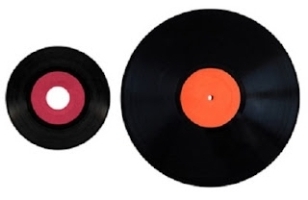
|
|
There were two sizes of record, based on how fast they were rotated by the record player. 45's were smaller, and turned at 45 rpm. Larger vinyl records turned at 33 ⅓ rpm. The larger records had better quality sound, and although you could only play one side, it held on average 12 songs.
45's came in a paper sleeve with no information; a label on the disc listed the artist, author, and recording company.
|
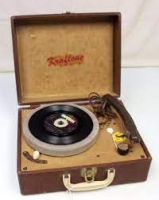
|
|
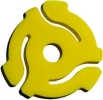 45's were usually played on small inexpensive record players. The speaker was built in to the player, and was generally pretty crappy. Since these machines could also play 33 ⅓ rpm records, an adapter was needed for the 45's. 45's were usually played on small inexpensive record players. The speaker was built in to the player, and was generally pretty crappy. Since these machines could also play 33 ⅓ rpm records, an adapter was needed for the 45's.
More expensive versions of these players might have detachable stereo speakers to better reproduce music from the superior-sounding 33 ⅓'s. Some had a special spindle in the center that would allow you to stack records, to play one after the other. With four or five 33 ⅓ rpm albums stacked, they would play unattended for several hours.
|

|
|
Vinyl records worked this way: music was played, and an engraving device, vibrating with the music, made impressions, following a spiral path, on a metal disc. This master copy was pressed into hot vinyl blanks. These vinyl discs, when played with a needle following the spirals, would vibrate just as the original music did. Using magnets, this would generate an electric curent , whose vibrations also mimiced the music. This signal could be boosted to power speakers, which would reproduce the original music faithfully.
|
In use, vinyl records had many problems. The biggest was that they scratched easily. With 45's, this didn't matter too much, since they didn't have great sound quality to begin with. But 33 ⅓ record albums produced high definition stereo sound, and scratches not only degraded the music, but could cause the music to skip or repeat. Fingerprints and dust would cause annoying crackles in the music.
Great care had to be taken when removing the discs from their cardboard sleeves and placing them on the turntable. The discs had to be regularly wiped down with a special cloth and cleaning solution.
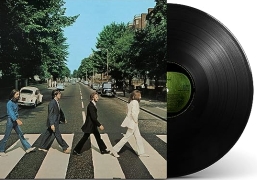
|
|
33 ⅓ rpm Vinyl Records
When these discs were clean and free of scratches, the music played back from them, especially on a high quality turntable with an expensive needle, was warm and rich, unmatched by anything before or since, except for CD discs. Recently there has been a resurgence in vinyl music, which music lovers have sought, given the limitations of current digital music.
|
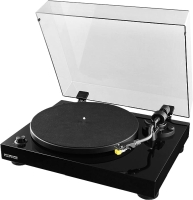
|
|
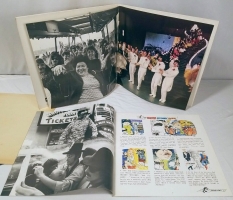 The large size of these records allowed for amazing cover art, and interior sides and inserts that contained lyrics, pictures and information about the artist that was often unavailable anywhere else.
The large size of these records allowed for amazing cover art, and interior sides and inserts that contained lyrics, pictures and information about the artist that was often unavailable anywhere else.
Sometimes the artist would release a double album with two discs in the same album. This could give you about 24 new songs, all in one package.
|
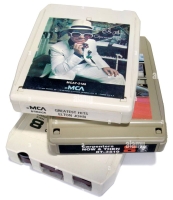
|
|
8-Track Tapes
Music recorded on magnetic tapes came next. Let's look at 8-track tapes. These were big and awkward, most commonly used in cars, but car players often ate the tapes, ruining them. 8-track tapes featured four 'programs'. A listener could toggle from program to program. The original tracks had to be shuffled from their intended sequence; long tracks would be split in two, causing gaps in the playback.
They could play continuously in an endless loop for about 80 minutes, and would start again at the beginning. Because of the loop, there was no rewind.
|
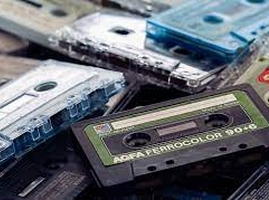
|
|
Cassette Tapes
These magnetic tapes came in a smaller case, and could hold 2 hours of music. They quickly replaced 8-tracks, and musical artists released their albums on this medium. Tape players were at first not very good for playing music, as they'd originally been developed for recording voice only; this resulted in jerky playback because of the non-constant speed of the motors. However, this was quickly fixed.
|
A bigger problem was the low hissing that was endemic to magnetic recording tape. A solution was found by electronically removing the hiss; a company named Dolby added their electronic 'fix' to all cassette players.
Cassette music could be official releases, in cases that included sheets of art, lyrics and other information about the artist. However, many people supplemented their cassette music collection by filling blank cassettes with music taped from the radio (boom boxes with both a radio and cassette player made this easy to do). One could also copy other people's cassettes, whether they were originals or self-recorded collections, just as easily. This was the origin of the 'mix tape'.
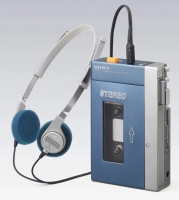 Despite the fact that the music quality on a cassette couldn't quite match that of 33 ⅓ vinyl records, many people abandoned vinyl records and started their own collections of cassette tapes. The two media existed side-by-side in stores for years, but cassettes soon took over the market with the invention of the portable cassette player, noteably the 'Sony Walkman'.
Despite the fact that the music quality on a cassette couldn't quite match that of 33 ⅓ vinyl records, many people abandoned vinyl records and started their own collections of cassette tapes. The two media existed side-by-side in stores for years, but cassettes soon took over the market with the invention of the portable cassette player, noteably the 'Sony Walkman'.
The sound quality of these devices wasn't equal to that of cassettes played on an expensive deck, but the lesser quality of the small earphones made that a moot point. For the first time, people could take their own music collections with them!
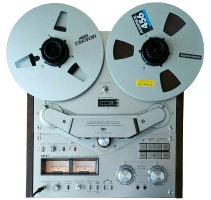
|
|
Reel-to-Reel Tape Recorders
These machines were much more expensive, but the quality of music played back on them was exceptional, rivalling that of vinyl records. Although official releases of artists' music was very rarely on this medium, it was fairly simple to copy music from a turntable or cassette machine onto a reel. Large tape reels like the ones pictured at the left could play for hours and hours. I had one, and had many reels of recorded music.
|
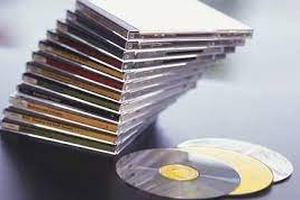
|
|
Music on CD's
Compact discs quickly came to dominate the market, and made vinyl records and cassettes all but obsolete. CD music was of a quality equal to or better than vinyl discs, and when played on an expensive CD player with large speakers, the sound was incredible.
People very quickly collected music in libraries of CDs, either original releases, or discs copied ('burned') from the original.
CDs had one disadvantage, however, similar to that of vinyl discs. It was time consuming to find a particular song. And while portable CD players existed, carrying a huge set of CDs around with you was awkward.
|
MP3 (Digital) Music
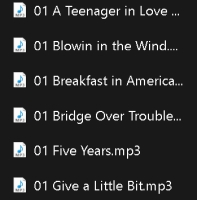 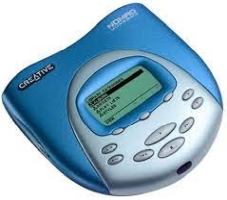 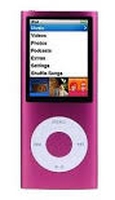
Music recorded in, or converted to, this format, can be stored on computers or portable playback devices, or streamed over the internet. The most well-known of the devices was the Apple iPod, and of course now, your phone.
There is a problem with MP3s. The bit rate of a digital signal is a measure of how accurately a sample of music is reproduced, or how much information can be transmitted per second. This is also known as bandwidth. CD's have a bit rate of 1,411 kbps (kilobits per second), which is very good.
MP3s, on the other hand, have a bitrate of just 320 kbps. When an original recording is compressed into an MP3 file, a lot of information is lost, often in the high and low frequencies. Similarly, streamed music can have a bitrate as low as 160 kbps. A lot of the details that artists and mixing engineers work hard to put into a recording are diminished or disappear entirely in an MP3 file. You aren't hearing the music the way it was meant to be heard.
Here's the catch ... if you're listening to the music on earbuds or cheap headphones, you'll never notice the lower quality. This also means that it's kind of silly to pay for really expensive headphones to play MP3 music that's already lower quality.
While I appreciate the portability or convenience of MP3 music or streaming, especially on my phone, I also miss the expensive component stereo system I used to have, with an amplifier and huge floor speakers. The music experience it provided was incredible.
Resources
Content, HTML, graphics & design by Bill Willis 2023
|

 Despite the fact that the music quality on a cassette couldn't quite match that of 33 ⅓ vinyl records, many people abandoned vinyl records and started their own collections of cassette tapes. The two media existed side-by-side in stores for years, but cassettes soon took over the market with the invention of the portable cassette player, noteably the 'Sony Walkman'.
Despite the fact that the music quality on a cassette couldn't quite match that of 33 ⅓ vinyl records, many people abandoned vinyl records and started their own collections of cassette tapes. The two media existed side-by-side in stores for years, but cassettes soon took over the market with the invention of the portable cassette player, noteably the 'Sony Walkman'. 





 45's were usually played on small inexpensive record players. The speaker was built in to the player, and was generally pretty crappy. Since these machines could also play 33 ⅓ rpm records, an adapter was needed for the 45's.
45's were usually played on small inexpensive record players. The speaker was built in to the player, and was generally pretty crappy. Since these machines could also play 33 ⅓ rpm records, an adapter was needed for the 45's.


 The large size of these records allowed for amazing cover art, and interior sides and inserts that contained lyrics, pictures and information about the artist that was often unavailable anywhere else.
The large size of these records allowed for amazing cover art, and interior sides and inserts that contained lyrics, pictures and information about the artist that was often unavailable anywhere else. 


